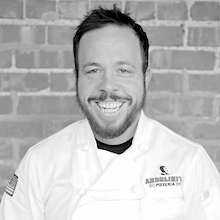Don’t just blindly set a price point based on the competition

Mike Bausch
Owner, Andolini’s Pizzeria, Tulsa, OK
Awhile ago I had a general manager who really wanted to change the beer prices of his store. He was emphatic that if we came down on price to matching or just under other local restaurants’ pricing, that his store would have an increase in bar sales. I want my staff to have ownership and a say in their stores, so I went along for the ride to see if his theory panned out. It did not. It failed, and that store’s sales didn’t change — but his food cost on beer suffered.
What I learned from this experiment was not to price solely according to the competition, but rather to price according the customer I want to attract. There are two types of customer: experience driven and value driven. The classic approach to menu building was to cater to one or the other. I’ve learned to cater to both.
That means that instead of having beers priced in the median range of what is acceptable, I price to the ends of the spectrum. Whatever is cheap with a solid profit margin and is approachable to the customer, I have that for the value-driven consumer. Depending on your area, menu and price spread you should have some items that are priced for a wow factor. Then I also have high-end bottles and rare beers that are priced on the high end of the spectrum.
 This logic applies to the whole menu. Approachably priced items along with luxuriously priced items is what I have found to be a solid pricing strategy.
This logic applies to the whole menu. Approachably priced items along with luxuriously priced items is what I have found to be a solid pricing strategy.
The classic logic for menu pricing typically breaks down into either:
A) What the market will bear — looking at the competition’s pricing for a large pizza and making sure yours doesn’t stray too far off. (Kind of short sighted and potentially disastrous if your product is more expensive to make).
B) Straight food cost: Take the cost of the item down to the penny and then multiply the price times four or five to get to the cost of your item depending if you are shooting for a 20-percent or 25-percent food cost. (Can be problematic for higher priced items that you price out of the range for people to buy them).
I’m not against using either logic to inform your result, but neither is a strategy. Your goal should not lie solely with food cost, but also with food profit. Sometimes food costing doesn’t allow for the customer’s tendency. If you typically sell three beers to the average mid demo 35-year-old customer, making $5 profit per beer is preferable to $3 profit per beer. However, selling three $11 beers that cost you $6 each is horrible food cost, but more profit than selling three $5 beers that cost you $2 each. One yields $15 in profit; the other option yields $9. The worse food cost translates into more cash in this example.
There’s a lot of science to this. Depending on your demo’s median income, your restaurant’s price perception and your overall experience, you can get more profit if you look at each item individually.
YOU MUST start with actual food cost to make sure the item is profitable. I find out my bottom price so that I never lose money. Then I strategize by looking at “What is the most I could get for this item with story and salesmanship?” If the item has a high perceived value, but is great on food cost, I either price the item very high and incentivize my servers to sell this item, or I use this item as an added-value item for deals or a bargain item for lunch and/or late-night crowds. If the item is high in food cost, I know not to do deals with it because it will never have a price “wow” factor. In that case, my best bet is to go for the experience “wow” factor and price the item as such at the top of the price spectrum.
MIKE BAUSCH is the owner of Andolini’s Pizzeria in Tulsa, Oklahoma. He is a frequent speaker at the International Pizza Expo family of tradeshows.







